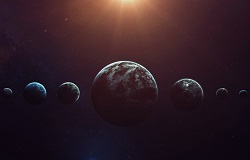Jaw-dropping discovery of earth-like planets revealed to the world
‘The discovery of multiple rocky planets with surface temperatures which allow for liquid water make this amazing system an exciting future target in the search for life,’ enthusiastically summed up Dr Chris Copperwheat, from the Liverpool John Moores University in the UK, who was part of the international research team. In their recent 22 February 2017 publication in the journal ‘Nature’, astronomers led by Dr Michaël Gillon, lead author of the paper and SPECULOOS principal investigator from the STAR Institute at the University of Liege in Belgium, have located a planetary system containing seven planets revolving around a small red ultracool dwarf star named ‘TRAPPIST-1’. This star is some 39 light-years (229 trillion miles) from Earth and researchers used telescopes such as Liege’s TRAPPIST-Sud (named after Belgium’s famed Trappist beers), Chile’s Very Large Telescope (VLT) and NASA’s Spitzer to make in-depth photometric observations on the transiting configuration (regular light curves and passes in front of its host star) to establish the planets’ atmospheric properties. While astronomers have already discovered thousands of exoplanets (planets located outside our solar system) since the first discovery of such a world back in 1992, there are many reasons to be more excited at this latest discovery… and not just because TRAPPIST-1’s slow hydrogen burning means that it will live for another 10 trillion years, more than 700 times longer than the universe has existed so far. These observations show that at least seven planets are of similar size, temperature and illumination levels to Earth. At least the inner six planets are probably rocky like Earth and three of the planets (TRAPPIST-1 e, f and g) orbit the star’s ‘habitable zone’ (or ‘Goldilocks zone’ because conditions are supposedly ‘just right’) and could therefore harbour oceans of water that are theoretically possible homes for life. No other star system has ever provided mankind with such an opportunity as to study the atmosphere of exoplanets of similar size to Earth before. ‘This is an amazing planetary system - not only because we have found so many planets, but because they are all surprisingly similar in size to the Earth,’ commented Dr Michaël Gillon. Researchers now wish to conduct follow-up observations using NASA's James Webb Space Telescope and the European Southern Observatory (ESO) more powerful European Extremely Large Telescope to detect biological activity in the atmosphere and answer the biggest wonder of all: Is life ubiquitous in the Galaxy? The answer with conclusive evidence should come sooner rather than later. ‘We hope we will know if there's life there within the next decade,’ specified co-researcher Dr Amaury Triaud, from the Institute of Astronomy in Cambridge, the UK. The SPECULOOS project runs until December 2018 and has received just under EUR 2 million in EU funding to detect potentially habitable exoplanets well-suited for the detection of chemical traces of life with existing and near-to-come astronomical facilities. And they certainly may have achieved this aim following the incredible TRAPPIST-1 discovery! For more information, please see: SPECULOOS project website
Countries
Belgium



